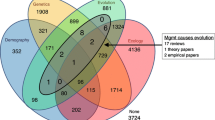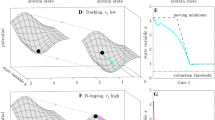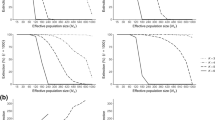Abstract
“Evolutionary rescue” is the potential for evolution to enable population persistence in a changing environment. Even with eventual rescue, evolutionary time lags can cause the population size to temporarily fall below a threshold susceptible to extinction. To reduce extinction risk given human-driven global change, conservation management can enhance populations through actions such as captive breeding. To quantify the optimal timing of, and indicators for engaging in, investment in temporary enhancement to enable evolutionary rescue, we construct a model of coupled demographic-genetic dynamics given a moving optimum. We assume “decelerating change”, as might be relevant to climate change, where the rate of environmental change initially exceeds a rate where evolutionary rescue is possible, but eventually slows. We analyze the optimal control path of an intervention to avoid the population size falling below a threshold susceptible to extinction, minimizing costs. We find that the optimal path of intervention initially increases as the population declines, then declines and ceases when the population growth rate becomes positive, which lags the stabilization in environmental change. In other words, the optimal strategy involves increasing investment even in the face of a declining population, and positive population growth could serve as a signal to end the intervention. In addition, a greater carrying capacity relative to the initial population size decreases the optimal intervention. Therefore, a one-time action to increase carrying capacity, such as habitat restoration, can reduce the amount and duration of longer term investment in population enhancement, even if the population is initially lower than and declining away from the new carrying capacity.




Similar content being viewed by others
References
Araki H, Berejikian BA, Ford MJ, Blouin MS (2008) Fitness of hatchery-reared salmonids in the wild. Evol Appl 1:342–355. https://doi.org/10.1111/j.1752-4571.2008.00026.x
Ashander J, Chevin L-M, Baskett ML (2016) Predicting evolutionary rescue via evolving plasticity in stochastic environments. Proc R Soc B 283:20161690
Baskett ML, Gaines SD, Nisbet M (2009) Symbiont diversity may help coral reefs survive moderate climate change. Ecol Appl 19:3–17
Baskett ML, Nisbet RM, Kappel CV et al (2010) Conservation management approaches to protecting the capacity for corals to respond to climate change: a theoretical comparison. Glob Chang Biol 16:1229–1246
Baskett ML, Waples RS (2013) Evaluating alternative strategies for minimizing unintended fitness consequences of cultured individuals on wild populations. Conservation Biology 27:83–94. https://doi.org/10.1111/j.1523-1739.2012.01949.x
Bellwood DR, Hughes TP, Folke C, Nyström M (2004) Confronting the coral reef crisis. Nature 429:827–829
Beverton RJ, Holt SJ (1957) On the dynamics of exploited fish populations. Springer, New York
Birgin EG, Martínez JM (2008) Improving ultimate convergence of an augmented Lagrangian method. Optim Methods Softw 23:177–195
Borja Á, Dauer DM, Elliott M, Simenstad CA (2010) Medium-and long-term recovery of estuarine and coastal ecosystems: patterns, rates and restoration effectiveness. Estuar Coasts 33:1249–1260
Boulding EG, Hay T (2001) Genetic and demographic parameters determining population persistence after a discrete change in the environment. Heredity 86:313–24
Bradshaw AD (1996) Underlying principles of restoration. Can J Fish Aquat Sci 53:3–9
Bürger R, Lynch M (1995) Evolution and extinction in a changing environment: a quantitative-genetic analysis. Evolution 49:151–163
Carlson SM, Cunningham CJ, Westley PAH (2014) Evolutionary rescue in a changing world. Trends Ecol Evol 29:521–530. https://doi.org/10.1016/j.tree.2014.06.005
Chevin L-M, Lande R, Mace GM (2010) Adaptation, plasticity, and extinction in a changing environment: towards a predictive theory. PLoS Biol 8:e1000357. https://doi.org/10.1371/journal.pbio.1000357
Chevin LM, Cotto O, Ashander J (2017) Stochastic evolutionary demography under a fluctuating optimum phenotype. Am Nat 190:786–802
Chow GC (1997) Dynamic economics: optimization by the Lagrange method. Oxford University Press, New York
Christie MR, Marine ML, French RA, Blouin MS (2012) Genetic adaptation to captivity can occur in a single generation. Proc Natl Acad Sci 109:238–42. https://doi.org/10.1073/pnas.1111073109
Crozier LG, Hendry AP, Lawson PW et al (2008) Potential responses to climate change in organisms with complex life histories: evolution and plasticity in Pacific salmon. Evolutionary Applications 1:252–270. https://doi.org/10.1111/j.1752-4571.2008.00033.x
Davis MB, Shaw RG, Etterson JR (2005) Evolutionary responses to changing climate. Ecology 86:1704–1714. https://doi.org/10.1890/03-0788
Ellner S, Hairston NG Jr (1994) Role of overlapping generations in maintaining genetic variation in a fluctuating environment. Am Nat 143:403–417
Flather CH, Hayward GD, Beissinger SR, Stephens PA (2011) Minimum viable populations: is there a ‘magic number’ for conservation practitioners? Trends Ecol Evol 26:307–16. https://doi.org/10.1016/j.tree.2011.03.001
Ford MJ (2002) Selection in captivity during supportive breeding may reduce fitness in the wild. Conserv Biol 16:815–825
Fraser DJ (2008) How well can captive breeding programs conserve biodiversity? a review of salmonids. Evol Appl 1:535–586
Gilpin M, Soule ME (1986) Minimum viable populations: processes of species extinction. Conservation biology: the science of scarcity and diversity Sinauer Associates, Sunderland, Massachusetts, pp 19–34
Gomulkiewicz R, Holt R (1995) When does evolution by natural selection prevent extinction? Evolution 41:201–207
Griffiths RA, Pavajeau L (2008) Captive breeding, reintroduction, and the conservation of amphibians. Conserv Biol 22:852–861
Heppell SS, Crowder LB, Crouse DT (1996) Models to evaluate headstarting as a management tool for long-lived turtles. Ecol Appl 6:556–565
Johnson SG (2016) The NLopt nonlinear-optimization package. http://ab-initio.mit.edu/nlopt, Accessed August 8, 2018
King DA (2004) Climate change science: adapt, mitigate, or ignore? Science 303:176–177. https://doi.org/10.1126/science.1094329
Kopp M, Matuszewski S (2013) Rapid evolution of quantitative traits: Theoretical perspectives. Evol Appl 7:169–191. https://doi.org/10.1111/eva.12127
Lampert A, Hastings A (2014) Optimal control of population recovery–the role of economic restoration threshold. Ecol Lett 17:28–35
Lande R (1976) Natural selection and random genetic drift in phenotypic evolution. Evolution 30:314–334
Lande R (1982) A quantitative genetic theory of life history evolution. Ecol 63:607–615
Lande R (1998) Anthropogenic, ecological and genetic factors in extinction and conservation. Res Popul Ecol 40:259–269
Lande R, Arnold S (1983) The measurement of selection on correlated characters. Evolution 37:1210–1226
Lirman D, Schopmeyer S (2016) Ecological solutions to reef degradation: optimizing coral reef restoration in the Caribbean and Western Atlantic. PeerJ 4:e2597
Lynch M, Lande R (1993) Evolution and extinction in response to environmental change. In: Kareiva P, Kingsolver J, Huey R (eds) Biotic interactions and global change. Sinauer, Sunderland, MA, USA, pp 234–250
Meinshausen M, Smith SJ, Calvin K et al (2011) The RCP greenhouse gas concentrations and their extensions from 1765 to 2300. Climatic change 109:213–241
Merilä J, Hendry AP (2014) Climate change, adaptation, and phenotypic plasticity: the problem and the evidence. Evol Appl 7:1–14. https://doi.org/10.1111/eva.12137
Mumby PJ, Sanchirico JN, Broad K et al (2017) Avoiding a crisis of motivation for ocean management under global environmental change. Glob Chang Biol 23:4483–4496
Myers JH, Simberloff D, Kuris AM, Carey JR (2000) Eradication revisited: dealing with exotic species. Trends Ecol Evol 15:316–320
Naish KA, Taylor JE III, Levin PS, Quinn TP, Winton JR, Huppert D, Hilborn R (2007) An evaluation of the effects of conservation and fishery enhancement hatcheries on wild populations of salmon. Adv Mar Biol 53:61–194
van Oppen MJ, Oliver JK, Putnam HM, Gates RD (2015) Building coral reef resilience through assisted evolution. Proc Natl Acad Sci 112:2307–2313
Reed TE, Schindler DE, Hague MJ, et al. (2011) Time to evolve? potential evolutionary responses of fraser river sockeye salmon to climate change and effects on persistence. PLoS One 6:e20380
Rice K, Emery N (2003) Managing microevolution: restoration in the face of global change. Front Ecol Environ 1:469–478
Ruffino L, Salo P, Koivisto E et al (2014) Reproductive responses of birds to experimental food supplementation: a meta-analysis. Front Zool 11:80
Scott JM, Goble DD, Haines AM et al (2010) Conservation-reliant species and the future of conservation. Conserv Lett 3:91–97
Sinervo B, Mendez-de-la-cruz F, Miles DB et al (2010) Erosion of lizard diversity by climate change and altered thermal niches. Science 328:894–899
Snyder NF, Derrickson SR, Beissinger SR et al (1996) Limitations of captive breeding in endangered species recovery. Conserv Biol 10:338–348
Stein BA, Staudt A, Cross MS et al (2013) Preparing for and managing change: climate adaptation for biodiversity and ecosystems. Front Ecol Environ 11:502–510
Thomas CD, Cameron A, Green RE et al (2004) Extinction risk from climate change. Nature 427:145–148
Turelli M, Barton NH (1994) Genetic and statistical analyses of strong selection on polygenic traits: what, me normal? Genetics 138:913–941
Urban MC (2015) Accelerating extinction risk from climate change. Science 348:571–573
Wallace B (1975) Hard and soft selection revisited. Evolution 29:465–473
Weeks A, Sgrò CM, Young A (2011) Assessing the benefits and risks of translocations in changing environments: a genetic perspective. Evol Appl 4:709–725. https://doi.org/10.1111/j.1752-4571.2011.00192.x
Acknowledgements
Thanks to Alan Hastings and Michael Turelli for feedback on an earlier draft. Special thanks to Lisa Crozier, with whom a conversation planted the seed of the question investigated here. Also special thanks to Alan Hastings, for whom this special issue is in honor, for his generosity as both a mentor and collaborator, as well as the continued inspiration from his research program to engage in multidisciplinary research and apply models to conservation challenges.
Funding
This project was funded by the REACH IGERT as a Bridge RA (NSF DGE-0801430 to P.I. Strauss) to JA.
Author information
Authors and Affiliations
Corresponding author
Electronic supplementary material
Appendices
Appendix A: Initialization and convergence of optimal paths
We initialized all optimization runs from the optimal path found with zero discount rate with uniform random initial conditions, and run for 2,500 iterations (Fig. 4). To assess convergence, we re-ran each parameter combination for 1000, 2000, and 2500 iterations for different random seeds. The longer runs showed consistent paths (Figs. 5 and 6), which is a criterion for convergence recommended for global optimization algorithms like the augmented Lagrangian method we employed (Johnson 2016).
Optimal paths for increasing run times (lighter grays) to show convergence of control paths for different budgets (columns) and discount rates (subpanel rows) at three carrying capacities corresponding to aK = 10,000, bK = 15,000. There are three runs shown in each panel: 1000, 2000, and 2500 iterations. In most cases, the two longest runs resulted in the same path
Optimal paths for increasing run times (lighter grays) to show convergence of population trajectories for different budgets (columns) and discount rates (subpanel rows) at three carrying capacities corresponding to aK = 10,000, bK = 15,000. There are three runs shown in each panel: 1000, 2000, and 2500 iterations. In most cases, the two longest runs resulted in the same path.
Appendix B: Code and graphics
We performed all numerical analyses in R using the nloptr package to perform optimization and dplyr to manage numeric outputs; we provide R code and metadata for optimal paths in Online Resource 1; the optimal path used for initial conditions is provided in Online Resource 2 and the optimal paths for all parameter combinations are provided in Online Resource 3. We produced all graphics using R packages ggplot2 and cowplot.
Rights and permissions
About this article
Cite this article
Ashander, J., Thompson, L.C., Sanchirico, J.N. et al. Optimal investment to enable evolutionary rescue. Theor Ecol 12, 165–177 (2019). https://doi.org/10.1007/s12080-019-0413-8
Received:
Accepted:
Published:
Issue Date:
DOI: https://doi.org/10.1007/s12080-019-0413-8






